
Isaac Asimov was an American writer and professor of biochemistry at Boston University. During his lifetime, Asimov was considered one of the "Big Three" science fiction writers, along with Robert A. Heinlein and Arthur C. Clarke. A prolific writer, he wrote or edited more than 500 books. He also wrote an estimated 90,000 letters and postcards. Best known for his hard science fiction, Asimov also wrote mysteries and fantasy, as well as popular science and other non-fiction.

Asimov's Science Fiction is an American science fiction magazine edited by Sheila Williams and published by Dell Magazines, which is owned by Penny Press. It was launched as a quarterly by Davis Publications in 1977, after obtaining Isaac Asimov's consent for the use of his name. It was originally titled Isaac Asimov's Science Fiction Magazine, and was quickly successful, reaching a circulation of over 100,000 within a year, and switching to monthly publication within a couple of years. George H. Scithers, the first editor, published many new writers who went on to be successful in the genre. Scithers favored traditional stories without sex or obscenity; along with frequent humorous stories, this gave Asimov's a reputation for printing juvenile fiction, despite its success. Asimov was not part of the editorial team, but wrote editorials for the magazine.
This is a bibliography of the books written or edited by Isaac Asimov, arranged alphabetically. Asimov was a prolific author, and he engaged in many collaborations with other authors. This list may not yet be complete. The total number of books listed here is over 500. Asimov died in 1992 at age 72; a small number of his books were published posthumously.
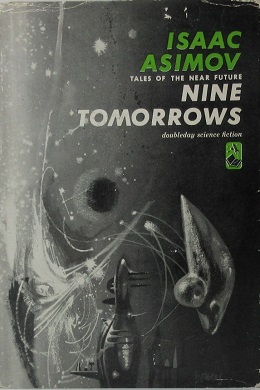
Nine Tomorrows is a collection of nine short stories and two pieces of comic verse by American writer Isaac Asimov. The pieces were all originally published in magazines between 1956 and 1958, with the exception of the closing poem, "Rejection Slips", which was original to the collection. The book was first published in the United States in 1959 and in the UK in 1963. It includes two of Asimov's favorite stories, "The Last Question" and "The Ugly Little Boy".

The Best of Isaac Asimov is a collection of twelve science fiction short stories by American writer Isaac Asimov, published by Sphere in 1973. It begins with a short introduction giving various details on the stories, such as how they came to be written, or what significance merits their inclusion in a "best of" collection, as well as some of Dr. Asimov's thoughts on a best of collection itself. The stories included are two of his early works, two of his late works (post-1960), and eight from the 1950s, which he refers to as his "golden decade" in the introduction. Except for the last story in the book, "Mirror Image", none of the stories are related to his Robot and Foundation series, while a few mention the Multivac computer.

"Marooned off Vesta" is a science fiction short story by American writer Isaac Asimov. It was the third story he wrote, and the first to be published. Written in July 1938 when Asimov was 18, it was rejected by Astounding Science Fiction in August, then accepted in October by Amazing Stories, appearing in the March 1939 issue. Asimov first included it in his 1968 story collection Asimov's Mysteries, and subsequently in the 1973 collection The Best of Isaac Asimov.
"The Dying Night" is a science fiction short story by American writer Isaac Asimov. The story first appeared in the July 1956 issue of The Magazine of Fantasy & Science Fiction, and was reprinted in the collections Nine Tomorrows (1959), Asimov's Mysteries (1968), and The Best of Isaac Asimov (1973). "The Dying Night" is Asimov's third Wendell Urth story.

"Anniversary" is a science fiction short story by American writer Isaac Asimov. It was first published in the March 1959 issue of Amazing Stories and subsequently appeared in the collections Asimov's Mysteries (1968) and The Best of Isaac Asimov (1973).
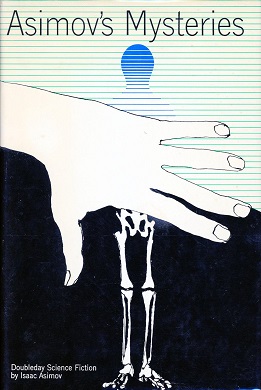
Asimov's Mysteries, published in 1968, is a collection of 14 short stories by American writer Isaac Asimov, almost all of them science fiction mysteries. The stories were all originally published in magazines between 1954 and 1967, except for "Marooned off Vesta", Asimov's first published story, which first appeared in 1939.

The Green Slime is a 1968 tokusatsu science fiction film directed by Kinji Fukasaku and produced by Walter Manley and Ivan Reiner. It was written by William Finger, Tom Rowe and Charles Sinclair from a story by Reiner. The film was shot in Japan with a Japanese director and film crew, but with the non-Japanese starring cast of Robert Horton, Richard Jaeckel and Luciana Paluzzi.
"The Singing Bell" is a science fiction mystery short story by American writer Isaac Asimov, which first appeared in the January 1955 issue of The Magazine of Fantasy and Science Fiction and was reprinted in the 1968 collection Asimov's Mysteries. "The Singing Bell" was the first of Asimov's Wendell Urth stories.

Asteroids have appeared in fiction since at least the late 1800s, the first one—Ceres—having been discovered in 1801. They were initially only used infrequently as writers preferred the planets as settings. The once-popular Phaëton hypothesis, which states that the asteroid belt consists of the remnants of the former fifth planet that existed in an orbit between Mars and Jupiter before somehow being destroyed, has been a recurring theme with various explanations for the planet's destruction proposed. This hypothetical former planet is in science fiction often called "Bodia" in reference to Johann Elert Bode, for whom the since-discredited Titius–Bode law that predicts the planet's existence is named.

Sucker Bait is a science fiction novella by American writer Isaac Asimov. It was first serialized in the February and March 1954 issues of Astounding Science Fiction, and reprinted in the 1955 collection The Martian Way and Other Stories. It has also been adapted as an episode of the BBC anthology television series Out of the Unknown.
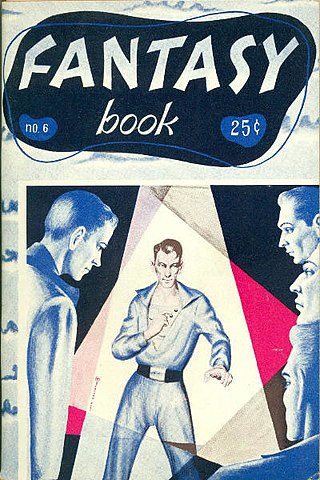
"Scanners Live in Vain" is a science fiction short story by American writer Cordwainer Smith. It was the first story in Smith's Instrumentality of Mankind future history to be published and the first story to appear under the Smith pseudonym. It first appeared in the semi-professional magazine Fantasy Book.
"The Dust of Death" is a science fiction/mystery short story by American writer Isaac Asimov, first published in the January 1957 issue of Venture Science Fiction Magazine and reprinted in the 1968 collection Asimov's Mysteries.
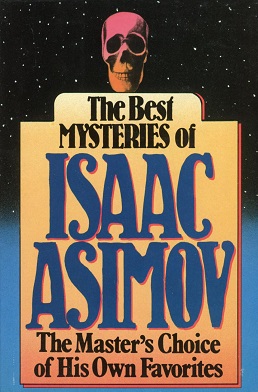
The Best Mysteries of Isaac Asimov is a collection of mystery short stories by American author Isaac Asimov. It was first published in hardcover by Doubleday in 1986, and in paperback by the Fawcett Crest imprint of Ballantine Books in September 1987.

The Asimov Chronicles: Fifty Years of Isaac Asimov is a collection of forty eight short science fiction and mystery stories and two science essays by American writer Isaac Asimov, published by Dark Harvest in May 1989.
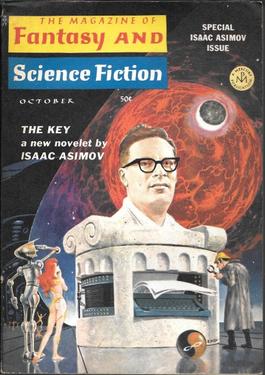
The Key is a science fiction mystery novelette by American writer Isaac Asimov. It is one of the stories featuring the reclusive scientist Wendell Urth. It first appeared in The Magazine of Fantasy & Science Fiction in October 1966, and was reprinted in the anthologies Asimov's Mysteries (1968) and The Best Mysteries of Isaac Asimov (1986).

"A Psychological Shipwreck" is a short story by American Civil War soldier, wit, and writer Ambrose Bierce and published by The Argonaut under the title "My Shipwreck" on May 24, 1879. It was included in the 1893 collection Can Such Things Be?
Depending on the counting convention used, and including all titles, charts, and edited collections, there may be currently over 500 books in Isaac Asimov's bibliography—as well as his individual short stories, individual essays, and criticism. For his 100th, 200th, and 300th books, Asimov published Opus 100 (1969), Opus 200 (1979), and Opus 300 (1984), celebrating his writing.














